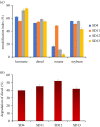Production optimization, stability and oil emulsifying potential of biosurfactants from selected bacteria isolated from oil-contaminated sites
- PMID: 34659780
- PMCID: PMC8511774
- DOI: 10.1098/rsos.211003
Production optimization, stability and oil emulsifying potential of biosurfactants from selected bacteria isolated from oil-contaminated sites
Abstract
Oil pollution is of increasing concern for environmental safety and the use of microbial surfactants in oil remediation has become inevitable for their efficacy and ecofriendly nature. In this work, biosurfactants of bacteria isolated from oil-contaminated soil have been characterized. Four potent biosurfactant-producing strains (SD4, SD11, SD12 and SD13) were selected from 27 isolates based on drop collapse assay and emulsification index, and identified as species belonging to Bacillus, Burkholderia, Providencia and Klebsiella, revealed from their 16S rRNA gene-based analysis. Detailed morphological and biochemical characteristics of each selected isolate were determined. Their growth conditions for maximum biosurfactant production were optimized and found quite similar among the four isolates with a pH of 3.0 and temperature 37°C after 6 or 7 days of growth on kerosene. The biosurfactants of SD4, SD11 and SD12 appeared to be glycolipids and that of SD13 a lipopeptide. Emulsification activity of most of the biosurfactants was stable at low and high temperatures (4-100°C), a wide range of pH (2-10) and salt concentrations (2-7% NaCl). Each biosurfactant showed antimicrobial activity against two or more pathogenic bacteria. The biosurfactants were well-capable of emulsifying kerosene, diesel and soya bean, and could efficiently degrade diesel.
Keywords: biosurfactant-producing bacteria; crude oil biodegradation; emulsification index; microbial surfactants; petroleum hydrocarbon bioremediation; production optimization.
© 2021 The Authors.
Figures




Similar articles
-
Production and characterization of surfactin-like biosurfactant produced by novel strain Bacillus nealsonii S2MT and it's potential for oil contaminated soil remediation.Microb Cell Fact. 2020 Jul 20;19(1):145. doi: 10.1186/s12934-020-01402-4. Microb Cell Fact. 2020. PMID: 32690027 Free PMC article.
-
Production of lipopeptide biosurfactants by Bacillus atrophaeus 5-2a and their potential use in microbial enhanced oil recovery.Microb Cell Fact. 2016 Oct 3;15(1):168. doi: 10.1186/s12934-016-0574-8. Microb Cell Fact. 2016. PMID: 27716284 Free PMC article.
-
Production of rhamnolipids and diesel oil degradation by bacteria isolated from soil contaminated by petroleum.Biotechnol Prog. 2016 Mar;32(2):262-70. doi: 10.1002/btpr.2208. Epub 2015 Dec 8. Biotechnol Prog. 2016. PMID: 26588432
-
Recent advances of biosurfactant for waste and pollution bioremediation: Substitutions of petroleum-based surfactants.Environ Res. 2022 Sep;212(Pt A):113126. doi: 10.1016/j.envres.2022.113126. Epub 2022 Mar 25. Environ Res. 2022. PMID: 35341755 Review.
-
Biosurfactant: A new frontier for greener technology and environmental sustainability.Ecotoxicol Environ Saf. 2019 Nov 30;184:109607. doi: 10.1016/j.ecoenv.2019.109607. Epub 2019 Sep 7. Ecotoxicol Environ Saf. 2019. PMID: 31505408 Review.
Cited by
-
Assessment of the in-vitro probiotic efficacy and safety of Pediococcus pentosaceus L1 and Streptococcus thermophilus L3 isolated from Laban, a popular fermented milk product.Arch Microbiol. 2024 Jan 31;206(2):82. doi: 10.1007/s00203-023-03812-5. Arch Microbiol. 2024. PMID: 38294545
-
Production and characterization of bioemulsifier by Parapedobacter indicus.Front Microbiol. 2023 Feb 16;14:1111135. doi: 10.3389/fmicb.2023.1111135. eCollection 2023. Front Microbiol. 2023. PMID: 36876100 Free PMC article.
-
Production and optimization of surfactin produced from locally isolated Bacillus halotolerans grown on agro-industrial wastes and its antimicrobial efficiency.BMC Microbiol. 2024 Jun 3;24(1):193. doi: 10.1186/s12866-024-03338-w. BMC Microbiol. 2024. PMID: 38831400 Free PMC article.
-
Tolerance and Metabolization of High-Concentration Heavy Crude Oil High-Concentration Heavy Crude Oil by Bacillus subtilis.Microorganisms. 2025 Jun 29;13(7):1520. doi: 10.3390/microorganisms13071520. Microorganisms. 2025. PMID: 40732028 Free PMC article.
-
Microbial biosurfactant-mediated green synthesis of zinc oxide nanoparticles (ZnO NPs) and exploring their role in enhancing chickpea and rice seed germination.Discov Nano. 2024 Nov 1;19(1):174. doi: 10.1186/s11671-024-04134-1. Discov Nano. 2024. PMID: 39487377 Free PMC article.
References
-
- Ahuja D, Tatsutani M.. 2009. Sustainable energy for developing countries. S.A.P.I.EN.S. Surveys and Perspectives Integrating Environment and Society.
-
- Saadoun IMK. 2015. Impact of oil spills on marine life. London, UK: IntechOpen.
-
- Bashir I, Lone FA, Bhat RA, Mir SA, Dar ZA, Dar SA. 2020. Concerns and threats of contamination on aquatic ecosystems. In Bioremediation and biotechnology: sustainable approaches to pollution degradation (eds Hakeem KR, Bhat RA, Qadri H), pp. 1-26. Cham, Switzerland: Springer International Publishing.
-
- Strømgren T, Sørstrøm SE, Schou L, Kaarstad I, Aunaas T, Brakstad OG, Johansen Ø. 1995. Acute toxic effects of produced water in relation to chemical composition and dispersion. Mar. Environ. Res. 40, 147-169. (10.1016/0141-1136(94)00143-D) - DOI
-
- Henderson SB, Grigson SJW, Johnson P, Roddie BD. 1999. Potential impact of production chemicals on the toxicity of produced water discharges from North Sea oil platforms. Mar. Pollut. Bull. 38, 1141-1151. (10.1016/S0025-326X(99)00144-7) - DOI
Associated data
LinkOut - more resources
Full Text Sources
Molecular Biology Databases

